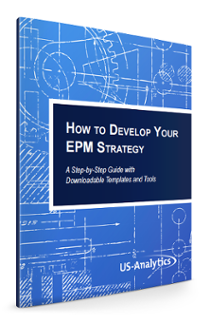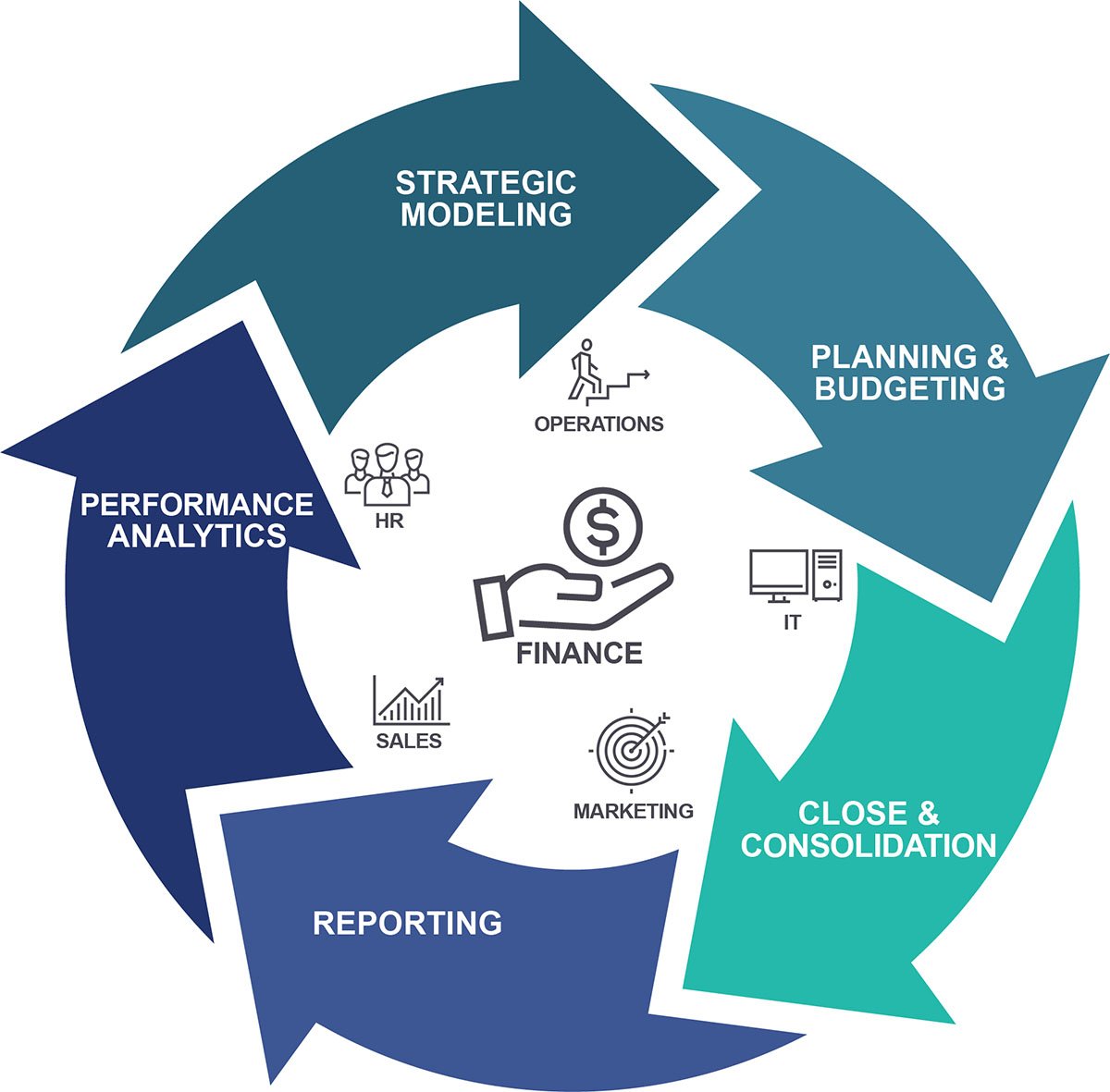Managing an enterprise is a multi-faceted challenge that requires patience, flexibility, and having the right tools in place in order to succeed. Enterprise Performance Management (EPM) software is a fantastic solution that allows its users the opportunity to view an abundance of detailed metrics at a glance, but it can be daunting and complicated to use and manage. There are a lot of details that go into effectively using EPM solutions, and unfortunately, many of its users are under-utilizing the potential of this powerful resource.
Let’s take a closer look at EPM, its components, and its products to find how it’s implemented most effectively by finance leaders in a variety of industries across the globe.
What is Enterprise Performance Management (EPM)?
Enterprise Performance Management, more commonly referred to as EPM, is a type of business planning used by a wide range of entities that involves the evaluation and management of an enterprise’s performance and ability to reach goals, increase efficiency, and maximize business processes. EPM drives the improved performance of an enterprise by comparing its results to its forecasts and goals.
The concept of EPM has existed for decades, spanning back to the Industrial Revolution as businesses then sought to automate processes to maximize their efficiency and increase their bottom line (think Henry Ford and his now-famous assembly line). In the 1970s the first rudimentary EPM software was implemented, paving the way to where we are now. EPM in the present makes the most out of today’s technology through the use of on-premises and cloud software systems to aggregate and analyze data.
EPM in relation to ERP
EPM is used interchangeably with other terms quite frequently, sometimes erroneously. While it is synonymous with Corporation Performance Management, or CPM, it is often confused with or mislabeled as ERP, or Enterprise Resource Planning. EPM and ERP are frequently used in tandem with one another and are most effective when they are integrated together. There may be some overlap between the two in the area of financial planning, but EPM and ERP are entirely different and should be regarded as such.
ERP is used to handle the day-to-day aspects of business from a micro level, such as capturing transactional data and other regular daily operations. EPM, on the other hand, is used to manage the business from a macro level, focusing on business analysis and reporting. EPM that integrates ERP into its applications creates more accurate reports and forecasts for analysis and distribution.
EPM business processes
The business processes associated with EPM can be broken down into five functional areas: Strategic modeling, planning and budgeting, close and consolidation, reporting, and performance analytics. Read on for an overview of each of these areas.
Strategic modeling
Strategic modeling allows users the opportunity to develop long-range strategic forecast models. It is useful for detailed forecasting and analysis of trends and frees up time spent on manually gathering data. Strategic modeling gives users a sense of confidence in the accuracy of their projections, reports, and audits.
Planning and budgeting
Using EPM software for planning and budgeting gives users flexibility and scalability with their forecasts. While standard EPM products include out-of-the-box planning content, others, such as Oracle EPM, go a step further and provide the user with the ability to create custom parameters for future planning and budgeting.
Close and consolidation
EPM software can be used for streamlining financial close and consolidation, making it easy for users to report on their business with confidence. This support gives users peace of mind when it comes to meeting global regulatory requirements and provides the requisite transparency of data for stakeholders both internal and external.
Reporting
Financial reporting has been revolutionized by EPM software. It provides a format for neat, consistent, standardized reporting. EPM software can be used to consolidate briefs into executive reports, distribute report content to stakeholders, and integrate financial decisions, among other functionalities.
Performance analytics
Analyzing past performance is made easier and more accurate than ever before with EPM technology. EPM technology is used to conveniently analyze trends across years, divisions, and against planned performance. This data creates a holistic picture of the enterprise that is invaluable for leadership, management, and stakeholders.
EPM products
Now that we’ve established what EPM and its business processes are, it’s important to understand some of the different EPM products on the market and what the software can do for you and your team.
Oracle Hyperion
Oracle Hyperion is a popular choice of EPM technology. It is well-established, giving the company and its representatives years of experience and institutional knowledge in EPM solutions that it passes down to its clients.
Hyperion is made up of several applications, including…
● Hyperion Planning
● Hyperion Financial Management (HFM)
● Hyperion Financial Close Management (HFCM)
● Hyperion Financial Data Quality Management Enterprise Edition (FDMEE)
Oracle Hyperion is an on-premises EPM technology, but the current roadmap has full support ending in 2030. To get a look at the roadmap of the next (and, perhaps last) version of Hyperion, check out this blog post.
Oracle EPM Cloud
Oracle EPM Cloud is an Oracle Hyperion software as a service (SaaS) product. It requires no investments in hardware or upfront capital, making it an increasingly popular EPM solution for a variety of enterprises. While there is controversy surrounding the idea of moving EPM technology to the cloud, it is convenient and a viable option for a growing number of businesses and organizations that use EPM technology regularly as well as smaller organizations who couldn’t afford the upfront costs of on-premises EPM solutions.
Oracle EPM Cloud supports the seamless integration of data from an enterprise’s ERP system to its EPM software, making the unification of the two platforms as straightforward as possible. This allows users to drill down into their ERP data directly through the Oracle EPM Cloud software.
Oracle EPM Cloud is made up of Oracle Planning and Budgeting Cloud Services (PBCS), Oracle Financial Consolidation and Cloud Close Service (FCCS), and Oracle Account Reconciliation Cloud Services (ARCS).
Though the solutions above are still referred to and used by legacy customers, Oracle has recently changed the structure of its cloud-based offerings, separating it into two offerings — Oracle EPM Standard Cloud and Oracle EPM Enterprise Cloud. The Enterprise version includes all of the same features and functions as the SaaS products listed above, while the standard version is a more affordable, lighter option.
For a more detailed look at the new offerings and the pricing structure, read this blog post.
OneStream XF
OneStream XF is a user-friendly unified EPM technology platform. It was developed to give users the ability to plan and forecast, reconcile accounts, and conduct financial consolidation and reporting in one solution. OneStream XF breaks down inter-departmental siloes to create a centralized software for EPM users.
OneStream XF uses increased automation and improved controls to regulate workflow and reduce errors. It uses familiar programs, such as Microsoft Excel, to increase its intuitiveness and simplify usage.
Other EPM Solutions
Oracle EPM solutions and OneStream XF are just two examples of EPM or CPM technologies. There are many other your organization might consider, such as…
- Host Analytics
- Info
- Prophix
- Anaplan
Evaluating an EPM technology is an involved process with many considerations. Many finance leaders opt for an industry expert to guide them in the process, applying their decades of experience to an organization’s specific EPM needs. US-Analytics has developed a methodology to assist organizations in choosing an EPM vendor. To find out more, contact us.
Conclusion
EPM is a powerful tool for finance managers, CFOs, and other management personnel to have at their disposal. Effective use of EPM technology permeates every aspect of an enterprise and gives leadership a more holistic picture of an organization’s health. But without proper EPM strategy and support, it can be overwhelming to navigate.
For a more in-depth look at EPM, EPM strategy, and EPM products, check out our eBook…








